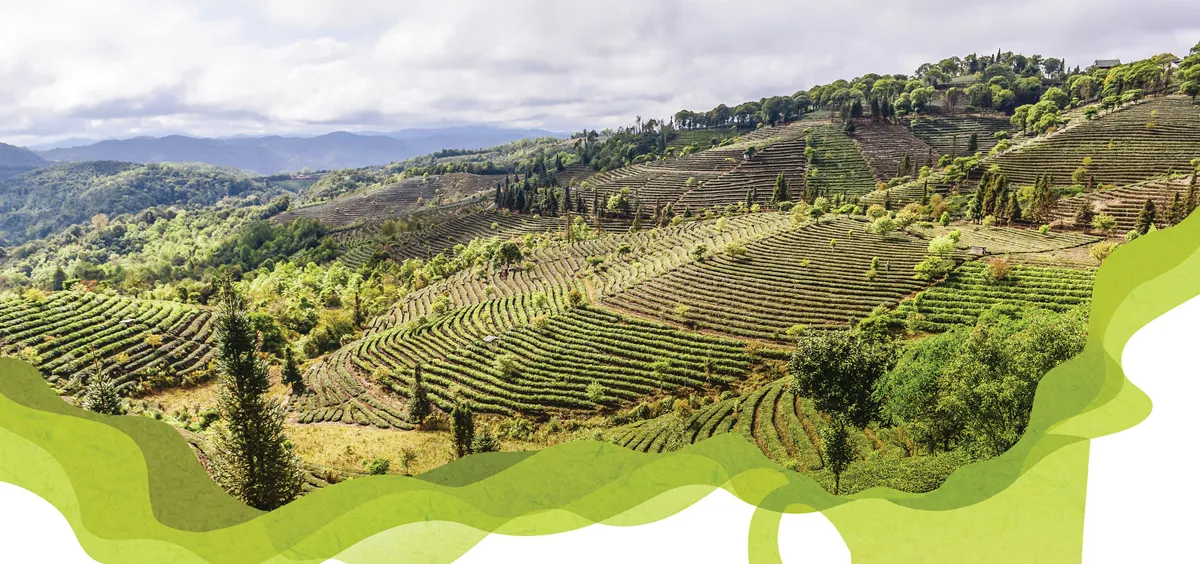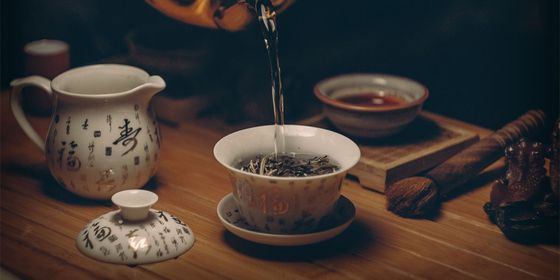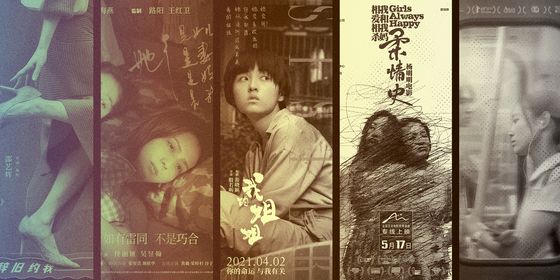Yunnan’s famous tea harvest combines legend, history, and high-stakes speculation
Like a proud yet worried father, Qu Bo pats the trunk of a tree and pries an unwelcome green vine off a branch, discarding it onto the forest floor with a grimace.
For over a decade, “Old Qu” has tended to 200 semi-wild tea trees on the slopes of Nannuo Mountain in the southern Yunnan province. “These aren’t your father’s father’s trees,” the pepper-haired orchard keeper says of his grove, which are said to have been planted two to three centuries ago. “These are your grandfather’s grandfather’s trees.”
It’s April, and fuzzy little buds have begun to form at the tips of branches as the pu’er tea harvest of Nannuo Mountain swings into full motion. Farmers rush to pick the early spring buds, which can fetch a higher price if sold before the Qingming Festival. The mountain towns spring to life as pickers arrive from neighboring towns to help with the harvest, and collectors from as far as Kunming, Taipei, and Seoul swarm the orchards to strike deals with growers.
Picker Yu spends an entire day gathering buds from a single gushu tea
The Camellia sinensis (var. assamica) in Qu’s orchard is the source of “ancient tree” tea, or gushucha (古树茶), the most highly coveted form of pu’er. Freshly-picked leaves of this tea produce a yellow-green brew. The fermented version, which turns amber in boiled water, is downed by the potful at dim sum restaurants around the world, or delicately sipped in precious wares at Chinese connoisseurs’ tables.
Those who savor fermented pu’er call it “earthy” or “mushroomy”; less appreciative drinkers have likened the taste to moldy garbage. Taiwanese tea expert Deng Shihai, who penned the “pu’er bible” Pu’er Tea in 1941, made the opaque declaration that the highest achievable realm of pu’er flavor is a “tasteless taste.”
According to Qu, the elusive quality that confounds connoisseurs’ description is pu’er’s gift: “Drinking gushu pu’er is like listening to music. Nobody wants to listen to a single boring melody—we want to listen to complex music. The taste of this tea is abundant; a symphony.”
Pu’er tea is in fact chemically different from green or black teas. It belongs to a rare category of “dark” or fermented teas. The tea has been called a “drinkable antique,” since the labor of enzymes through years, decades, or even centuries of storage gives the tea an ever-evolving taste, supposedly elevating with age—as does the price. Like wine, or single-malt whiskey, pu’er tea is nearly always identified by the mountain from which its leaves are sourced, the factory in which it is processed, and the year of production.
Qu brews his leaves to taste for astringency
Over the last few decades, pu’er has gained a cult-like following, with some of the costliest tea leaves exceeding their weight in gold. At the Guangzhou International Trade Fair in 2002, a 100-gram portion of pu’er was auctioned for 168,000 RMB, dethroning tieguanyin green tea as the most expensive tea in the world. In Beijing, a three-gram portion reached 32 times the price of gold in a 2004 auction.
During the market’s hottest years leading up to the “Pu’er Tea Bubble” of 2007, wholesale tea markets kept desktop monitors listing the fluctuating cost-per-kilogram of pu’er, as if trading stocks or futures. Prices could rise or fall by 500 RMB in a day. Even today, Qu divulges that one kilogram of his leaves, once dried and packaged, retails for over 1,000 RMB.
As Qu prunes the orchard of harmful growths and leaves the symbiotic ones, he explains that the taste of the brew will vary based on minute details of the tree’s environment, from its soil and water source to its unique ecology of parasites. Thus, each mountain is known for its local flavor profile, from Yiwu’s famed mellow lingering aftertaste to Mengku’s bold sweet-to-bitter range; and each year’s leaves have a slightly different tang.
“The truth emerges in the cup,” winks Qu, hinting at the large number of fakes on the market that attempt to emulate his prized ancient tree leaves.
The oldest pu’er trees in Nannuo are said to be 1,200 years old. Natural historians and scientists agree that this mountainous area on the border of southwestern China and Myanmar was the birthplace of the tea tree, a species that flourished naturally in the tropical highlands long before humans thought to boil and drink its leaves.
The first instance of tea drinking was recorded in the Classic of Poetry, written between the 11th and 7th century BCE. The Ba people of neighboring Sichuan province were said to offer a prototype of pu’er tea to kings of the Zhou dynasty (1046 – 256 BCE), proving the plant to be one of the oldest pillars of the regional economy. The tea was brought down from the mountains to the trading town of Pu’er, and was distributed on routes that stretched north to Beijing, west to Tibet, and south to Bangkok and Haiphong.
The Ancient Tea Horse Road is reenacted for tourists in Lijiang
During the Tang dynasty (618 – 907 CE), the Ancient Tea Horse Road connected Yunnan, Sichuan, and Tibet in the tea trade. The leaves were valued for helping Tibetans digest their meat-based meals. Legend has it that fermented pu’er emerged from these long journeys. Traders carried compressed cakes of pu’er on their back, piled high over their head; the sunlight and rainfall naturally fermented the leaves along the way.
The journey, treacherous and steep as it ascended from the Xishuangbanna lowlands to the Himalayas, has its own set of lore. The heroine Ashimei, who is said to have commanded a caravan of 100 drivers and 300 horses, walking 750,000 kilometers over her lifetime, once tragically declared, “For women, this road is a path of love hanging onto their lives; for men, this road is a path of life and death hanging onto the cliffs.”
In the 18th century, local families began to establish commercial brands. A former Hunanese soldier surnamed Liu, whose garrison was sent to put down a rebellion and then settled in Xishuangbanna, founded the family tea business Tongqing Hao. The operation soon became the most renowned in Yunnan, directly supplying restaurants, merchants, and collectors in Hong Kong and Taiwan.
Local officials selected Tongqing Hao to produce imperial tribute for the Qing emperors. Beginning in 1732, caravans of mules and horses set off from Pu’er city and arrived months later in Beijing carrying five-kilogram spheres of dried tea leaves. “Longjing [tea] in summer, pu’er in winter” was a popular saying, as the partially fermented tea helped the northerners digest their greasy winter diets until the tributary expeditions ended in 1904.
In the last century, the twists and turns of the pu’er tea industry trace the dramatic rebirth of modern China. In 1938, Yunnan’s first tea factory opened its doors, processing leaves with imported machines from British India and Burma. However, the operation didn’t last long—wars ground tea production to a halt, and Tongqing Hao closed its doors in 1948 as sales plummeted. Tea growers and merchants entered what they called “the hunger years.”
Roaster Wang losses the day’s pick to assist with oxidation
During the Mao era, small tea businesses were consolidated and nationalized, and a new “wet-piling” technique sped up the fermentation of pu’er to within three months. However, there was literally no “market” for tea: From the 1950s to the 1980s, a kilogram of tea sold for less than 5 RMB.
As the economy gradually reopened in the 80s, a group of Taiwanese collectors visited Yiwu Mountain to find that tea production had faded into memory. Convincing local leaders of the lucrative potential of tea growing, the collectors called upon elderly villagers to share what they remembered of tea cultivation with young entrepreneurs. Everyone was relieved to find the ancient tea trees, undisturbed by the vicissitudes of human politics, still growing silently in their groves.
Since the 90s, pu’er tea has been central to the Yunnan provincial government’s new development strategy, which focuses on “powerful green economics,” “rich ethnic culture,” and “tour culture.”
As Kunming tea expert Xu Yahe once conjectured to author Zhang Jinghong, pu’er is not only a “certain production technique” or “biological categorization,” but a “historical geographical substance.” Steeped in the cup along with the plant is the symbolism: the authenticity of leaves that come from the birthplace of tea, the adventure of the Ancient Tea Horse Road; the prestige of imperial tribute.
To promote the product, the Yunnan government decided to reenact the imperial caravans in 2005, sending 120 mules and horses with 68 drivers on a 4,000-kilometer walking journey. The seven 357-gram cakes they carried were auctioned off in Beijing. One cake bought by the actor Zhang Guoli for 1.2 million RMB shook the tea-drinking world and cemented pu’er tea as a collector’s item.
Today, the cost of pu’er has stabilized considerably, and the cakes are increasingly snatched up by domestic connoisseurs, leaving little for export to foreign markets. The leaf is a new favorite investment of China’s rising middle class. While buyers of the past century were overwhelmingly from Hong Kong and Taiwan, mainland collectors have rushed into the market, with the largest numbers hailing from Kunming, Guangdong, and Beijing.
Wang’s husband roasts the leaves to halt enzyme activity
No longer the stuff of emperors and presidents, pu’er tea has entered ordinary households, lending them an air of culture as well as serving as a practical investment. Mr. Zhang, a taxi driver in Xishuangbanna, bought 50,000 RMB’s worth of pu’er tea from Yunnan’s renowned Yiwu Mountain when he got married four years ago. He proudly notes that his investment has already tripled in price.
“When my kid was born, I bought another batch,” Zhang says. “They all have the year on them. When the in-laws come over, or during a special occasion, you drink some. It’s a good memory.”
Old Huang, a collector from Guangdong province, hovers around Qu’s orchard. “You should pick them earlier,” he says sternly, “I can sell for a higher price.”
Qu pretends not to hear him. When Huang disappears from view, Qu explains that some growers will turn the soil or cut the branches so that the tree will sprout quicker. Qu’s trees have been growing semi-wild in the forest for hundreds of years, so he is loath to interfere with their natural wisdom: “My trees simply drink the morning dew, and absorb the glow of sunset. Nothing more.”
Huang and Qu represent two poles of pu’er philosophy: One wants the harvest controlled and the leaves fermented in a humidity-controlled storage space; the other allows the harvest to “happen when it happens,” and drinks the leaves with minimal processing. Huang is the commercialite, Qu is the pastoralist. Both are united in reverence of a well-brewed cup of pu’er, even if they disagree on what that means or how to get there.
High up on the trees, 25-year-old Yu Nanhe, her mother, and her aunt pick the young tea leaves, having driven from their hamlet to the foot of Qu’s fields to help with the harvest.
Recruiting through friends of friends for a few days of informal labor, Qu admits that at 100 RMB a day it “isn’t much, but can help out with their kids’ school fees, rice, salt, shoes and socks.”
As the afternoon rains begins to pour, the pickers crowd under the cover of an exposed wooden shed, where the leaves are laid out to dry.
“We used to have our own gushu trees,” says Yu, who is of the Dai ethnicity, with a sad smile, “But in the 90s, we were advised to cut them down and replace them with tea terraces. We were told it was scientific, and easier to pick and manage.”
“Now we pick 40-50 kilograms a day, but we still don’t make much money. We didn’t understand tea culture back then,” Yu laments—a lesson learned against the rash development of the 90s and the fickleness of connoisseurs’ tastes.
One 357-gram “cake” of pu’er can be sold for millions of yuan depending on origin, quality, and age
As dusk settles in, Qu calls his friend Wang Juan, of the Aini ethnicity, to tell her that the leaves are ready to roast. The Dai pickers wrap the day’s pick in plastic tarp, and pack it into Qu’s trunk. As soon as Wang spots Qu’s car in the yard, her husband begins shoveling coal into a furnace beneath four meter-long woks, firing it to 200 degrees Celsius.
In a process called “killing the green,” which halts enzyme activity to allow the tea to ferment gradually, Wang tosses the leaves on a bamboo platter, giving it a rhythmic shake, then deposits them into a sizzling wok. Four kilograms of wet leaves shrivel into one kilogram of dry matter.
“Take them out after 30 minutes,” orders Qu. When Wang’s husband protests, saying that it’s standard to roast the leaves for longer, Qu compares it to “strangling your leaves in a thick jacket.”
The craze for pu’er tea has left its mark on the tea villages of Yunnan, whose fortunes have been irrevocably tied to the price of tea: From the 1950s to the 70s, a family surnamed Guan lived in a thatched shed on the mountain. They now live in a new brick house they built for 250,000 RMB, with a car in the courtyard worth 130,000 RMB.
Wang’s house has also been newly remodeled into a spacious two-story home with tiled floors. After the day’s work is done, Qu prepares fresh-picked pu’er to share with Wang’s family. As the leaves steep, unfurling and blooming in the pot, Qu shares his worries about pu’er tea’s future.
“Young people don’t like to drink tea anymore,” sighs Qu, whose generation saw tea drinking as a reclamation of traditional Chinese culture after half a century of erasure from war and politics. Most growers, collectors, connoisseurs, and writers of pu’er, he admits, are around his age.
In recent years, the city of Pu’er, has ironically become the rising “coffee capital of China.” Province-wide, farmers have embraced the trendy new crop, growing 100,000 tons of coffee each year for corporations like Nestle and Starbucks.
Qu pours the yellow-green tea into small glass cups, and imbibes the pungent and complex brew which has ruled the region’s economy for millennia and vaulted a new generation of tea merchants to fame. But with international investment on one end, and the waning interest in traditional tea culture on the other, Qu wonders how long the reign of pu’er can last.
“Maybe we need to add some lemon flavor, or brown sugar, or some pretty packaging? Young people want excitement and innovation,” muses Qu, leaning back in his chair and closing his eyes in momentary intoxication.
A cold breeze wafts in from the open door, sending a frisson down the drinker’s spine. “But for us, when we drink tea, it is the very beauty and abundance of life.”
Pure Pu’er: Inside China’s High-Stakes Tea Harvest is a story from our issue, “High Steaks.” To read the entire issue, become a subscriber and receive the full magazine.












